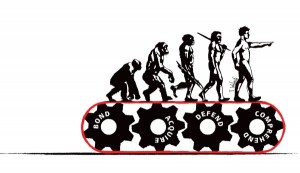Technology Management
NAB Radio Show Session
August 29, 2017 at 12:00 AM If you are going to the 2017 NAB Radio show in Austin, please come and see the session that I’ve put together with some help from my Vipology co-horts, “Unlock Higher Ratings and Revenue Through Data”.
If you are going to the 2017 NAB Radio show in Austin, please come and see the session that I’ve put together with some help from my Vipology co-horts, “Unlock Higher Ratings and Revenue Through Data”.
I’m really glad to have been engaged by the NAB to help them with content again this year. So that I don’t have to talk for 45 minutes - and you don’t want to hear it all from me anyway - we’ve assembled a panel of high-level experts when it comes to the impact that technology has had on research and media buying.
Permanent Link — Posted in Technology ManagementFive Things Rackspace Can Do To Win Again
May 14, 2013 at 12:00 AMI’ve been reading about slow growth for Rackspace cloud and how apps are pulling support. I shouldn’t be so surprised given that my own usage of the Rackspace cloud has also dwindled, despite the ORD datacenter being one of the most rock solid facilities I have ever used. I know that Rackspace has spent the last few years working hard and innovating, but somehow they seem to still be missing the boat. Here is a list of key things that made me go back to AWS and that Rackspace can implement to reverse this trend.
Permanent Link — Posted in Cloud Computing , Technology ManagementManagement and The Compliment Sandwich
April 22, 2013 at 12:00 AMHarvard Business Review has published an essay about the “sandwich approach” to giving negative feedback by Roger Schwarz. The essay takes issue with the practice of providing positive and negative feedback together. While I wouldn’t say that I stick to the positive-negative-positive format of the sandwich, I do try to balance feedback when I need to address an issue with a co-worker or employee. I try to find something positive to say that is in proportion to the negative points that I have to get across. Something light for a small issue, or larger praise to accompany the discussion and resolution of a larger issue.
Permanent Link — Posted in Technology ManagementBest Practices For Using Arch Linux on Servers
December 6, 2012 at 12:00 AMI’ve been running Arch Linux on my workstations and on servers for a long time. Every once in a while I see a debate in an Arch Linux forum about it’s suitability for use on production servers. Being a rolling release distribution, it is different than other distributions that concentrate on enterprise and long-term support like RedHat Enterprise and CentOS. Without getting too much into the pros and cons - one of the key reasons that I use Arch on servers is earlier access to newer technologies like the 3.0 Linux kernel series (with built-in xen support). Overall, though, it is due to my familiarity with and love for it. The OS that I load on my servers is there to support my applications. I find Arch is simple and light yet thorough and stable in getting the job done. If you are running Arch on servers or are interested in doing so, here are some practices that I recommend.
Permanent Link — Posted in Arch Linux , Technology Management , Geek TacticsTechnology Management Paradox
October 29, 2012 at 12:00 AM| The book, The CIO Paradox, by Martha Heller identifes some common contradicitions of managing technology, grouped into four main categories: |  |
|---|
Your Role:
- You were hired to be strategic, but you are forced to spend most of your time on operational issues.
- You are the steward of risk mitigation and cost containment, yet you are expected to innovate.
- Your function is seen as that of an enabler, yet you are also expected to be a business driver.
- IT can make or break a company, but you are not a member of the corporate board.
Your Stakeholders:
- You run one of the most pervasive, critical functions, yet you must prove your value constantly.
- Your many successes are invisible; your few mistakes are highly visible.
- You are intimately involved in every facet of the business, yet you are considered separate and removed from it.
- You are accountable for project success, but the business has ownership.
Your Organization/Team:
- Your staff loves technology but must embrace business to advance.
- Your team members are uncomfortable with people, but to succeed they must build relationships and influence others.
- You develop successors, yet the CEO almost always goes outside for the next CIO.
- You are forced to seek less expensive overseas sourcing, yet you are expected to ensure the profession.
Your Industry:
- Technology takes a long time to implement, yet your tool set changes constantly.
- Technology is a long-term investment, but the company thinks in quarters.
- Your tools cost a fortune, yet have the highest defect rate of any product.
- You sign vendors’ checks, yet they try their darndest to sell to your business peers.
I could add another category, “Your Management”. In many organizations, technology reports into finance. This was a natural fit because finance and accounting are in many cases the biggest “users” of IT and IT is seen as a cost center that needs to be reigned in. The book makes the case for the new IT paradigm which is based on visibility and accountability. Many organizations evolve slowly, however so those challenges are still real. According to a recent study by Gartner, the CMO will grow to be the biggest IT spender by 2017. Does this mean IT will eventually report to Marketing?
Permanent Link — Posted in Technology ManagementThe Ten Commandments of Egoless Programming
July 31, 2012 at 12:00 AMFrom The Psychology of Computer Programming by Gerald M. Weinberg, this is a great list to have posted in any dev shop.
- Understand and accept that you will make mistakes. The point is to find them early, before they make it into production. Fortunately, except for the few of us developing rocket guidance software at JPL, mistakes are rarely fatal in our industry, so we can, and should, learn, laugh, and move on.
- You are not your code. Remember that the entire point of a review is to find problems, and problems will be found. Don’t take it personally when one is uncovered.
- No matter how much “karate” you know, someone else will always know more. Such an individual can teach you some new moves if you ask. Seek and accept input from others, especially when you think it’s not needed.
- Don’t rewrite code without consultation. There’s a fine line between “fixing code” and “rewriting code.” Know the difference, and pursue stylistic changes within the framework of a code review, not as a lone enforcer.
- Treat people who know less than you with respect, deference, and patience. Nontechnical people who deal with developers on a regular basis almost universally hold the opinion that we are prima donnas at best and crybabies at worst. Don’t reinforce this stereotype with anger and impatience.
- The only constant in the world is change. Be open to it and accept it with a smile. Look at each change to your requirements, platform, or tool as a new challenge, not as some serious inconvenience to be fought.
- The only true authority stems from knowledge, not from position. Knowledge engenders authority, and authority engenders respect—so if you want respect in an egoless environment, cultivate knowledge.
- Fight for what you believe, but gracefully accept defeat. Understand that sometimes your ideas will be overruled. Even if you do turn out to be right, don’t take revenge or say, “I told you so” more than a few times at most, and don’t make your dearly departed idea a martyr or rallying cry.
- Don’t be “the guy in the room.” Don’t be the guy coding in the dark office emerging only to buy cola. The guy in the room is out of touch, out of sight, and out of control and has no place in an open, collaborative environment.
- Critique code instead of people—be kind to the coder, not to the code. As much as possible, make all of your comments positive and oriented to improving the code. Relate comments to local standards, program specs, increased performance, etc.
2012 Cloud Computing Adoption Survey
June 26, 2012 at 12:00 AMRackspace has put out a nice infographic highlighting what IT decision makers are looking for as well as what they are concerned about when it comes to cloud.
Rackspace® — Rogue IT, Cloud Lock-In Dominate Cloud Concerns [INFOGRAPHIC] ![Rackspace® — Rogue IT, Cloud Lock-In Dominate Cloud Concerns [INFOGRAPHIC]](http://c179631.r31.cf0.rackcdn.com/cloud-survey-infographic-edit.jpeg)
Adjusting IT for Cloud Computing
June 19, 2012 at 12:00 AMCloud Computing is not just a paradigm shift for infrastructure. IT operations, accounting and even staffing structure need to be updated to effectively harness the benefits.
In a previous article I illustrated deploying a multi-terrabyte RAID array in the cloud. That takes just a few minutes these days but it used to take most organizations over a month to provision that much storage through their IT channel. Moving to cloud will allow organizations to reduce and potentially eliminate IT staffing around procurement.
Permanent Link — Posted in Cloud Computing , Technology ManagementGoogle Data Integration: Could It Drive PIDM Adoption?
January 26, 2012 at 12:00 AMInteresting article from Forbes on Google’s privacy announcement and how it will drive the Personal Identity Management industry.
Personal Identity Management (PIDM), is heating up because of three factors:
- The formation of large online networks that collect data about consumers (Google, Facebook, Zynga)
- Web 2.0 technologies and trends to be open platforms creating access to that data
- Increased consumer and government awareness of privacy issues

Picture a Personal Identity Management solution as a dashboard that shows you what these big networks know about you and enable you to update or edit it where the policies allow it.
Permanent Link — Posted in Social Media , Technology Management , EntrepreneurialHuman Nature and Managing Technology Teams
September 9, 2011 at 12:00 AMManaging technology groups can be especially challenging. I attribute this to the way that technology attracts personality types that aren’t as common in traditional business roles. Specifically I am talking about the type of people that founded and continue to support the stereotypes of the technologist - the introverted, over-calm, over-ego’ed nerds and geeks.
Darwin’s Theory of Human Behavior suggests that we are all motivated by four drives: to acquire, to defend what we have acquired, to understand/comprehend the world around us, and to bond socially.
Permanent Link — Posted in Technology Management